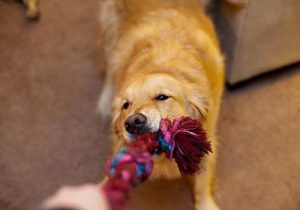There are so many myths out there about dog training that we decided to share 7 of the big ones with you. We’ve also included some tips so hopefully you can learn a thing or two along the way!
1. A dog who doesn’t learn fast or doesn’t learn at all is either stupid, stubborn or dominant
Of course we never want to admit that we are the actual problem. Every dog is able to learn, some of them slower, some of them faster – just like us humans. Often we don’t communicate what we want from them in the right way for our pooches to understand us.
It is important to reward your dog for something he has done right. If you notice that your dog gets distracted very fast, try to practice in a calm environment with as few distractions as possible. Once your dog has learnt the correct behaviour you can practice with him in more busy places, like your local doggy park.
2. A puppy has to be older than 6 months to start the training
This assumption is based on old theories and is not true. The basic training can start from 8 weeks on. This includes learning his name, where his sleeping-place is and where his food and water is located. You can also start housebreaking your puppy. After 6 to 7 months, your dog is ready for learning basic dog commands, like “sit”.
3. Positive reinforcement training doesn’t work for aggressive or stubborn dogs
The opposite is the case. Positive training is actually a very powerful and safe option for aggressive dogs. Most of the time they are aggressive, because they’re scared, stressed, and insecure and don’t know how to behave in certain situations. With the positive training, the dog gets rewarded for correct behaviour which helps him to figure out how to react and behave in the right way. This also releases his stress and anxiety, making the pooch relaxed.
4.’You can’t teach an old dog new tricks’
This is a very well known saying but completely incorrect! I am sure you know that it’s not true, nevertheless there are still a lot of people who believe it. This is maybe caused by the fact that older dogs sometimes take longer to change their old behaviour. In fact, for some some older dogs it is even easier to learn a new trick, because they can concentrate and are calmer than puppies
5. Dogs who show bad behaviour want to be dominant
Dogs do not try to be dominant over a human. What we understand as being dominant behaviour, like pulling on the leash, not listening to us or being aggressive, is a misinterpretation. And again, it’s our fault if our dog shows behaviour like this. It is attributable to wrong or non-existing training. If we don’t show the dog how to behave, he won’t do it right. He can only behave in the way we teach him.
 6. Playing tug causes aggression
6. Playing tug causes aggression
Playing tug does not cause aggression or trigger false behaviour, like biting. It is a game that most dogs absolutely love. But keep in mind that it is very important to set some rules for your dog. He should learn to stop or drop the toy on your command and also not to put his teeth on your skin while playing.
7. Using food in training is bribery
First of all, using food in training can have a very positive effect on your dog, especially on dogs who are scared and anxious. If there is a stimulus that causes a lot of stress or anxiety, giving food can have a calming effect and the pooch starts connecting the once stressful stimulus with a positive feeling.
But if you don’t always want to use treats, you can use anything that is a reward for your fur-child, like his favourite toy.
If you are currently training your dog and are planning a trip away its very important to advise your pet sitter of any set rules that your dog must abide by as well as commands that should be regularly used.

